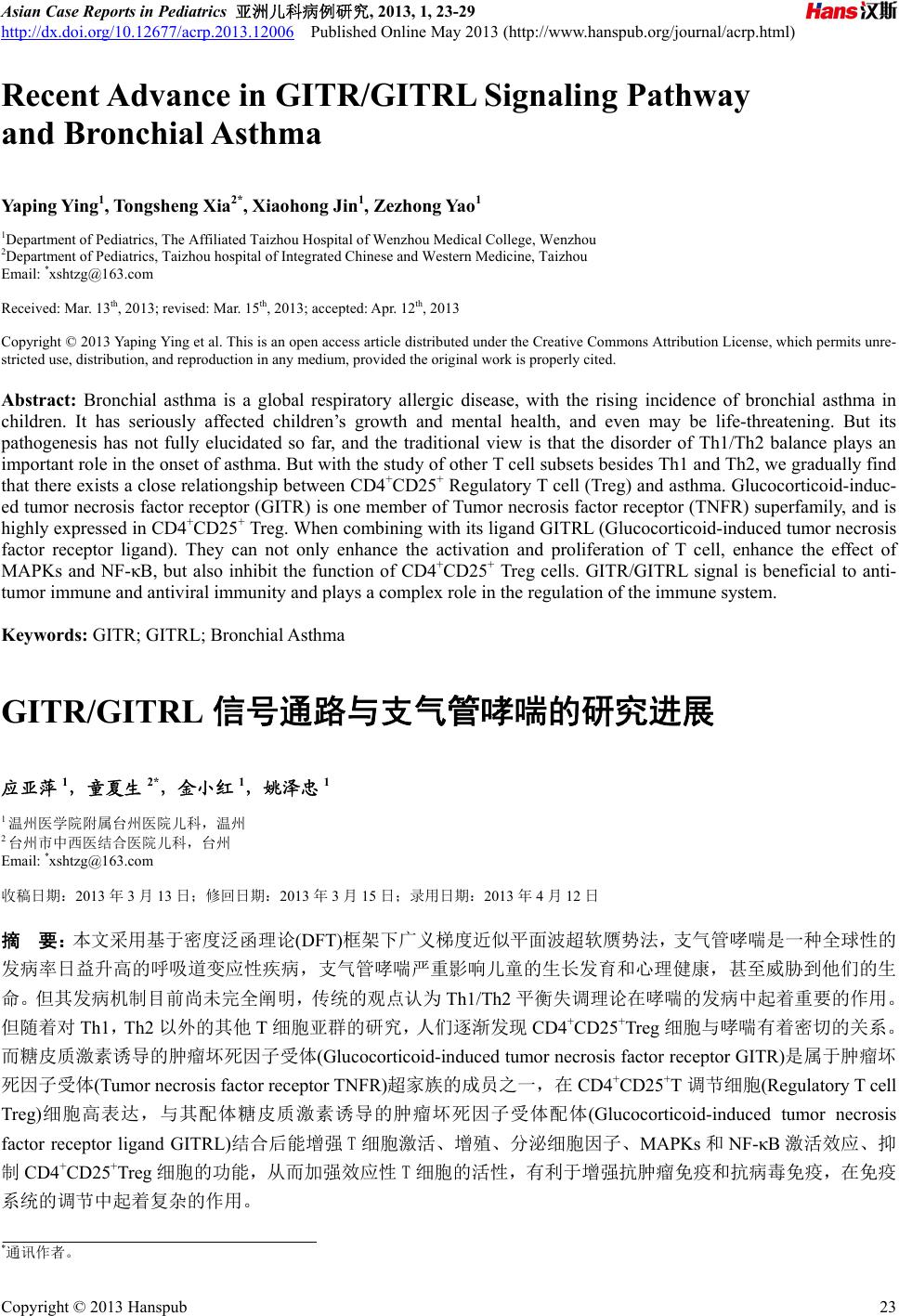 Asian Case Reports in Pediatrics 亚洲儿科病例研究, 2013, 1, 23-29 http://dx.doi.org/10.12677/acrp.2013.12006 Published Online May 2013 (http://www.hanspub.org/journal/acrp.html) Recent Advance in GITR/GITRL Signaling Pathway and Bronchial Asthma Yaping Ying1, Tongsheng Xia2*, Xiaohong Jin1, Zezhong Yao1 1Department of Pediatrics, The Affiliated Taizhou Hospital of Wenzhou Medical College, Wenzhou 2Department of Pediatrics, Taizhou hospital of Integrated Chinese and Western Medicine, Taizhou Email: *xshtzg@163.com Received: Mar. 13th, 2013; revised: Mar. 15th, 2013; accepted: Apr. 12th, 2013 Copyright © 2013 Yaping Ying et al. This is an open access article distributed under the Creative Commons Attribution License, which permits unre- stricted use, distribution, and reproduction in any medium, provided the original work is properly cited. Abstract: Bronchial asthma is a global respiratory allergic disease, with the rising incidence of bronchial asthma in children. It has seriously affected children’s growth and mental health, and even may be life-threatening. But its pathogenesis has not fully elucidated so far, and the traditional view is that the disorder of Th1/Th2 balance plays an important role in the onset of asthma. But with the study of other T cell subsets besides Th1 and Th2, we gradually find that there exists a close relationgship between CD4+CD25+ Regulatory T cell (Treg) and asthma. Glucocorticoid-induc- ed tumor necrosis factor receptor (GITR) is one member of Tumor necrosis factor receptor (TNFR) superfamily, and is highly expressed in CD4+CD25+ Treg. When combining with its ligand GITRL (Glucocorticoid-induced tumor necrosis factor receptor ligand). They can not only enhance the activation and proliferation of T cell, enhance the effect of MAPKs and NF-κB, but also inhibit the function of CD4+CD25+ Treg cells. GITR/GITRL signal is beneficial to anti- tumor immune and antiviral immunity and plays a complex role in the regulation of the immune system. Keywords: GITR; GITRL; Bronchial Asthma GITR/GITRL 信号通路与支气管哮喘的研究进展 应亚萍 1,童夏生 2*,金小红 1,姚泽忠 1 1温州医学院附属台州医院儿科,温州 2台州市中西医结合医院儿科,台州 Email: *xshtzg@163.com 收稿日期:2013 年3月13 日;修回日期:2013年3月15 日;录用日期:2013年4月12日 摘 要:本文采用基于密度泛函理论(DFT)框架下广义梯度近似平面波超软赝势法,支气管哮喘是一种全球性的 发病率日益升高的呼吸道变应性疾病,支气管哮喘严重影响儿童的生长发育和心理健康,甚至威胁到他们的生 命。但其发病机制目前尚未完全阐明,传统的观点认为 Th1/Th2平衡失调理论在哮喘的发病中起着重要的作用。 但随着对 Th1,Th2 以外的其他 T细胞亚群的研究,人们逐渐发现 CD4+CD25 +Treg 细胞与哮喘有着密切的关系。 而糖皮质激素诱导的肿瘤坏死因子受体(Glucocorticoid-induced tumor necrosis factor receptor GITR)是属于肿瘤坏 死因子受体(Tumor necrosis factor receptor TNFR)超家族的成员之一,在CD4+CD25+T调节细胞(Regulatory T cell Treg)细胞高表达,与其配体糖皮质激素诱导的肿瘤坏死因子受体配体(Glucocorticoid-induced tumor necrosis factor receptor ligand GITRL)结合后能增强T 细胞激活、增殖、分泌细胞因子、MAPKs 和NF-κB激活效应、抑 制CD4+CD25+Treg 细胞的功能,从而加强效应性 T细胞的活性,有利于增强抗肿瘤免疫和抗病毒免疫,在免疫 系统的调节中起着复杂的作用。 *通讯作者。 Copyright © 2013 Hanspub 23 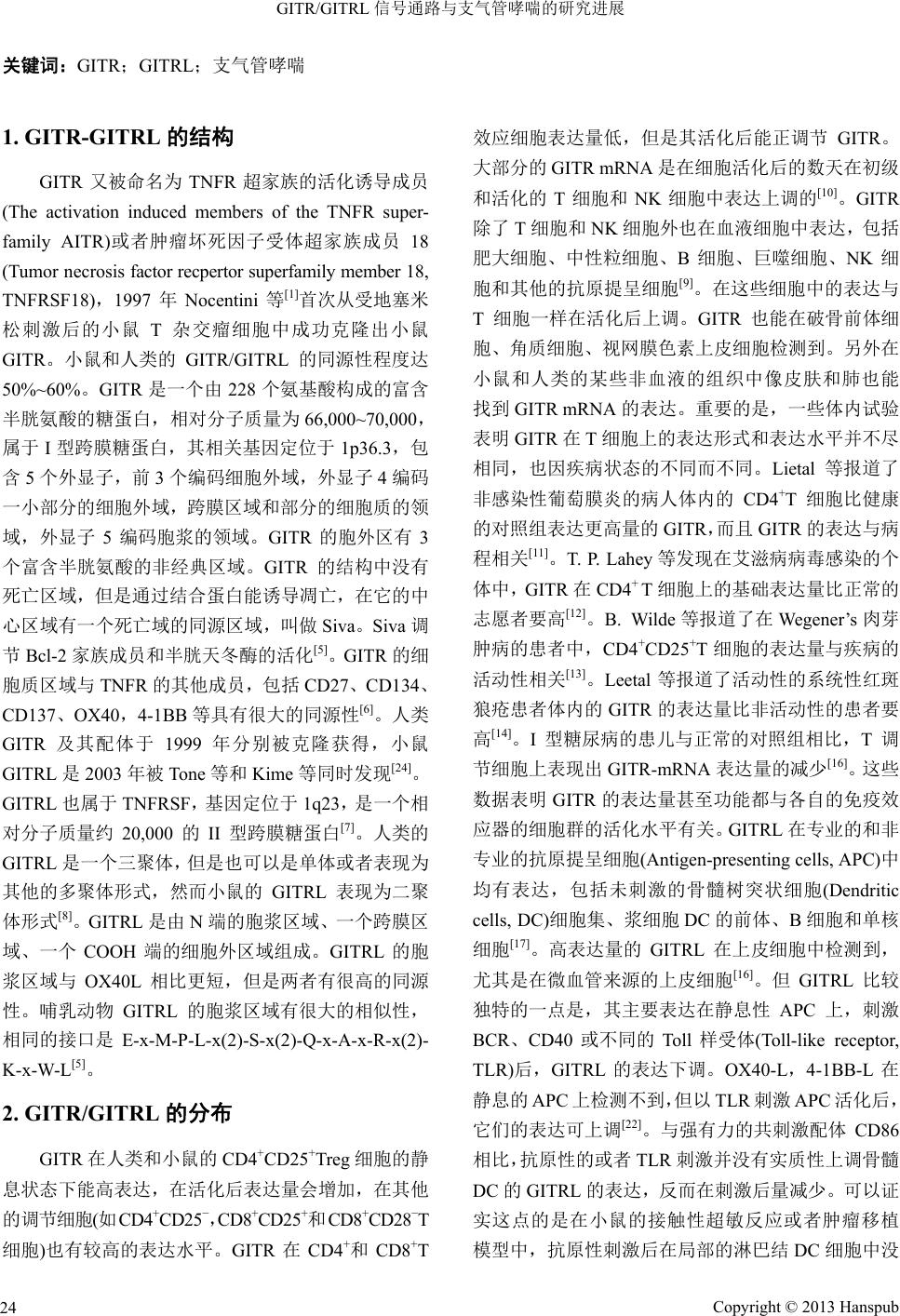 GITR/GITRL信号通路与支气管哮喘的研究进展 Copyright © 2013 Hanspub 24 关键词:GITR;GITRL;支气管哮喘 1. GITR-GITRL的结构 GITR 又被命名为 TNFR 超家族的活化诱导成员 (The activation induced members of the TNFR super- family AITR)或者肿瘤坏死因子受体超家族成员 18 (Tumor necrosis factor recpertor superfamily member 18, TNFRSF18),1997 年Nocentini 等[1]首次从受地塞米 松刺激后的小鼠 T杂交瘤细胞中成功克隆出小鼠 GITR。小鼠和人类的 GITR/GITRL 的同源性程度达 50%~60%。GITR 是一个由 228 个氨基酸构成的富含 半胱氨酸的糖蛋白,相对分子质量为 66,000~70,000, 属于 I型跨膜糖蛋白,其相关基因定位于 1p36.3,包 含5个外显子,前3个编码细胞外域,外显子4编码 一小部分的细胞外域,跨膜区域和部分的细胞质的领 域,外显子 5编码胞浆的领域。GITR 的胞外区有 3 个富含半胱氨酸的非经典区域。GITR 的结构中没有 死亡区域,但是通过结合蛋白能诱导凋亡,在它的中 心区域有一个死亡域的同源区域,叫做 Siva。Siva 调 节Bcl-2 家族成员和半胱天冬酶的活化[5]。GITR 的细 胞质区域与 TNFR 的其他成员,包括 CD27 、CD134、 CD137、OX40,4-1BB 等具有很大的同源性[6]。人类 GITR 及其配体于 1999 年分别被克隆获得,小鼠 GITRL 是2003 年被Tone 等和Kime 等同时发现[24]。 GITRL 也属于TNFRSF,基因定位于1q23,是一个相 对分子质量约 20,000 的II 型跨膜糖蛋白[7]。人类的 GITRL 是一个三聚体,但是也可以是单体或者表现为 其他的多聚体形式,然而小鼠的GITRL 表现为二聚 体形式[8]。GITRL 是由 N端的胞浆区域、一个跨膜区 域、一个 COOH端的细胞外区域组成。GITRL的胞 浆区域与 OX40L 相比更短,但是两者有很高的同源 性。哺乳动物GITRL 的胞浆区域有很大的相似性, 相同的接口是 E-x-M-P-L-x(2)-S-x(2)-Q-x-A-x-R-x(2)- K-x-W-L[5]。 2. GITR/GITRL的分布 GITR 在人类和小鼠的 CD4+CD25+Treg 细胞的静 息状态下能高表达,在活化后表达量会增加,在其他 的调节细胞(如CD4+CD25−,CD8+CD25+和CD8+CD28−T 细胞)也有较高的表达水平。GITR 在CD4+和CD8+T 效应细胞表达量低,但是其活化后能正调节 GITR。 大部分的 GITR mRNA是在细胞活化后的数天在初级 和活化的 T细胞和 NK细胞中表达上调的[10]。GITR 除了 T细胞和 NK细胞外也在血液细胞中表达,包括 肥大细胞、中性粒细胞、B细胞、巨噬细胞、NK 细 胞和其他的抗原提呈细胞[9]。在这些细胞中的表达与 T细胞一样在活化后上调。GITR 也能在破骨前体细 胞、角质细胞、视网膜色素上皮细胞检测到。另外在 小鼠和人类的某些非血液的组织中像皮肤和肺也能 找到 GITR mRNA的表达。重要的是,一些体内试验 表明 GITR在T细胞上的表达形式和表达水平并不尽 相同,也因疾病状态的不同而不同。Lietal 等报道了 非感染性葡萄膜炎的病人体内的 CD 4 +T细胞比健康 的对照组表达更高量的GITR,而且 GITR 的表达与病 程相关[11]。T. P. Lahey 等发现在艾滋病病毒感染的个 体中,GITR 在CD4+ T细胞上的基础表达量比正常的 志愿者要高[12]。B. Wilde等报道了在 Wegener’s 肉芽 肿病的患者中,CD4+CD25+T细胞的表达量与疾病的 活动性相关[13]。Leetal 等报道了活动性的系统性红斑 狼疮患者体内的 GITR 的表达量比非活动性的患者要 高[14]。I型糖尿病的患儿与正常的对照组相比,T调 节细胞上表现出GITR-mRNA 表达量的减少[16]。这 些 数据表明 GITR 的表达量甚至功能都与各自的免疫效 应器的细胞群的活化水平有关。GITRL在专业的和非 专业的抗原提呈细胞(Antigen-presenting cells, APC)中 均有表达,包括未刺激的骨髓树突状细胞(Dendritic cells, DC)细胞集、浆细胞DC 的前体、B细胞和单核 细胞[17]。高表达量的GITRL 在上皮细胞中检测到, 尤其是在微血管来源的上皮细胞[16]。但 GITRL 比较 独特的一点是,其主要表达在静息性 APC 上,刺激 BCR、CD40 或不同的 Toll 样受体(Toll-like receptor, TLR)后,GITRL 的表达下调。OX40-L,4-1BB-L 在 静息的 APC 上检测不到,但以 TLR 刺激 APC 活化后, 它们的表达可上调[22]。与强有力的共刺激配体 CD86 相比,抗原性的或者 TLR刺激并没有实质性上调骨髓 DC 的GITRL 的表达,反而在刺激后量减少。可以证 实这点的是在小鼠的接触性超敏反应或者肿瘤移植 模型中,抗原性刺激后在局部的淋巴结 DC 细胞中没 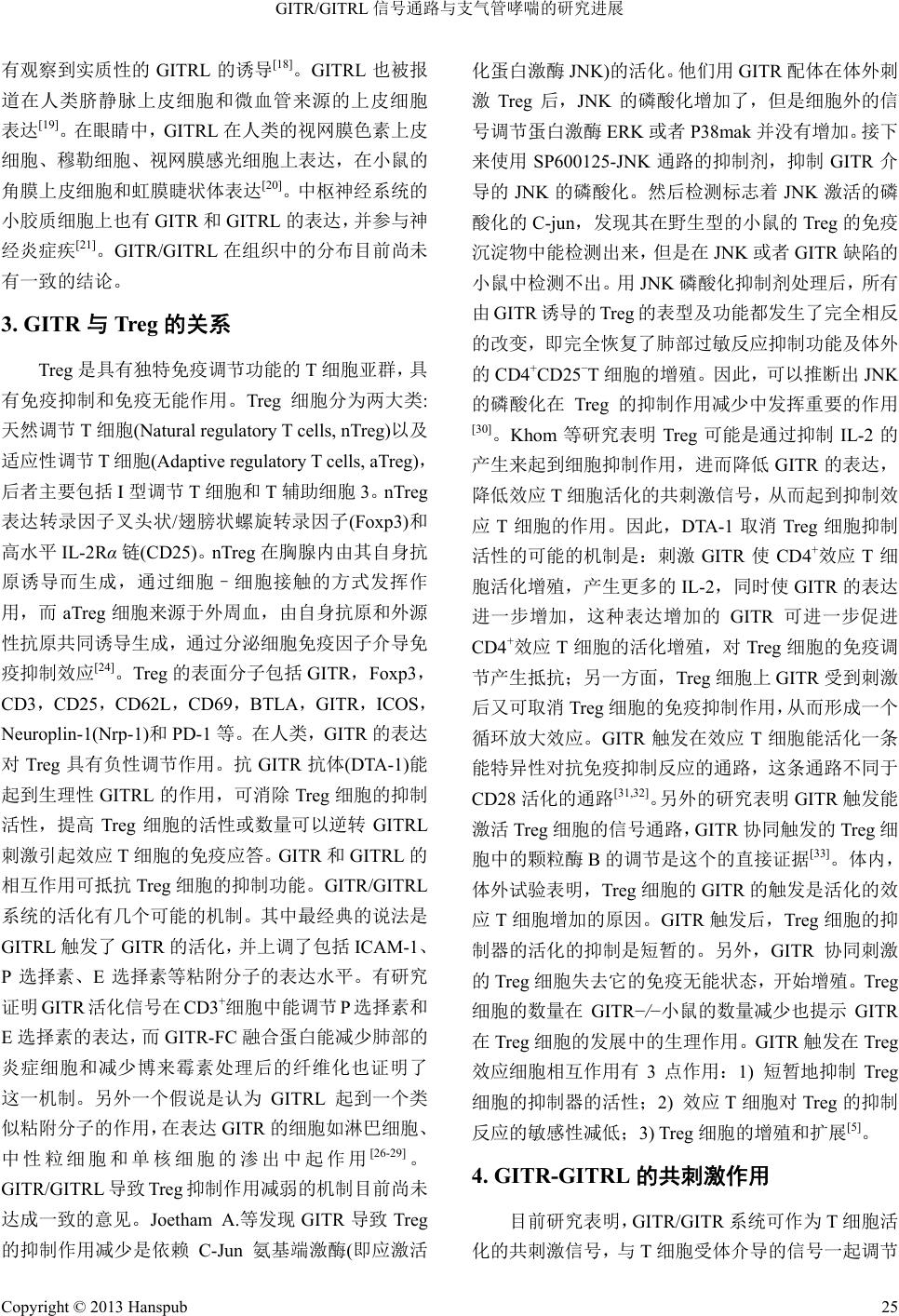 GITR/GITRL信号通路与支气管哮喘的研究进展 有观察到实质性的GITRL 的诱导[18]。GITRL 也被报 道在人类脐静脉上皮细胞和微血管来源的上皮细胞 表达[19]。在眼睛中,GITRL在人类的视网膜色素上皮 细胞、穆勒细胞、视网膜感光细胞上表达,在小鼠的 角膜上皮细胞和虹膜睫状体表达[20]。中枢神经系统的 小胶质细胞上也有GITR 和GITRL的表达,并参与神 经炎症疾[21]。GITR/GITRL 在组织中的分布目前尚未 有一致的结论。 3. GITR与Treg 的关系 Treg 是具有独特免疫调节功能的T细胞亚群,具 有免疫抑制和免疫无能作用。Treg 细胞分为两大类: 天然调节 T细胞(Natural regulatory T cells, nTreg)以及 适应性调节 T细胞(Adaptive regulatory T cells, aTreg), 后者主要包括I型调节 T细胞和T辅助细胞 3。nTreg 表达转录因子叉头状/翅膀状螺旋转录因子(Foxp 3) 和 高水平 IL-2Rα链(CD25)。nTreg 在胸腺内由其自身抗 原诱导而生成,通过细胞–细胞接触的方式发挥作 用,而 aTreg 细胞来源于外周血,由自身抗原和外源 性抗原共同诱导生成,通过分泌细胞免疫因子介导免 疫抑制效应[24]。Treg 的表面分子包括GITR,Foxp3, CD3,CD25 ,CD62L,CD 69 ,BTLA,GITR,ICOS, Neuroplin-1(Nrp-1)和PD-1 等。在人类,GITR 的表达 对Treg 具有负性调节作用。抗GITR 抗体(DTA-1)能 起到生理性 GITRL 的作用,可消除 Treg 细胞的抑制 活性,提高 Treg 细胞的活性或数量可以逆转GITRL 刺激引起效应T细胞的免疫应答。GITR 和GITRL 的 相互作用可抵抗 Treg 细胞的抑制功能。GITR/GITRL 系统的活化有几个可能的机制。其中最经典的说法是 GITRL 触发了GITR 的活化,并上调了包括ICAM-1、 P选择素、E选择素等粘附分子的表达水平。有研究 证明 GITR 活化信号在 CD3+细胞中能调节 P选择素和 E选择素的表达,而 GITR-FC 融合蛋白能减少肺部的 炎症细胞和减少博来霉素处理后的纤维化也证明了 这一机制。另外一个假说是认为GITRL 起到一个类 似粘附分子的作用,在表达 GITR 的细胞如淋巴细胞、 中性粒细胞和单核细胞的渗出中起作用[26-29] 。 GITR/GITRL 导致Treg 抑制作用减弱的机制目前尚未 达成一致的意见。Joetham A.等发现 GITR 导致Treg 的抑制作用减少是依赖 C-Jun 氨基端激酶(即应激活 化蛋白激酶 JNK)的活化。他们用 GITR 配体在体外刺 激Treg 后,JNK 的磷酸化增加了,但是细胞外的信 号调节蛋白激酶ERK 或者 P38mak并没有增加。接下 来使用 SP600125-JNK 通路的抑制剂,抑制 GITR 介 导的 JNK 的磷酸化。然后检测标志着 JNK 激活的磷 酸化的 C-jun,发现其在野生型的小鼠的Treg 的免疫 沉淀物中能检测出来,但是在 JNK 或者GITR 缺陷的 小鼠中检测不出。用JNK 磷酸化抑制剂处理后,所有 由GITR 诱导的 Treg 的表型及功能都发生了完全相反 的改变,即完全恢复了肺部过敏反应抑制功能及体外 的CD4+CD25−T细胞的增殖。因此,可以推断出 JNK 的磷酸化在 Treg 的抑制作用减少中发挥重要的作用 [30]。Khom 等研究表明 Treg 可能是通过抑制 IL-2 的 产生来起到细胞抑制作用,进而降低GITR 的表达, 降低效应 T细胞活化的共刺激信号,从而起到抑制效 应T细胞的作用。因此,DTA-1 取消 Treg 细胞抑制 活性的可能的机制是:刺激GITR 使CD4+效应 T细 胞活化增殖,产生更多的 IL-2,同时使 GITR 的表达 进一步增加,这种表达增加的 GITR可进一步促进 CD4+效应 T细胞的活化增殖,对 Treg 细胞的免疫调 节产生抵抗;另一方面,Treg 细胞上 GITR 受到刺激 后又可取消 Treg 细胞的免疫抑制作用,从而形成一个 循环放大效应。GITR触发在效应 T细胞能活化一条 能特异性对抗免疫抑制反应的通路,这条通路不同于 CD28 活化的通路[31,32]。另外的研究表明GITR 触发能 激活 Treg 细胞的信号通路,GITR 协同触发的 Treg 细 胞中的颗粒酶B的调节是这个的直接证据[33]。体内, 体外试验表明,Treg 细胞的 GITR 的触发是活化的效 应T细胞增加的原因。GITR触发后,Treg 细胞的抑 制器的活化的抑制是短暂的。另外,GITR 协同刺激 的Treg 细胞失去它的免疫无能状态,开始增殖。Treg 细胞的数量在 GITR−/−小鼠的数量减少也提示GITR 在Treg 细胞的发展中的生理作用。GITR 触发在Treg 效应细胞相互作用有 3点作用:1) 短暂地抑制Treg 细胞的抑制器的活性;2) 效应 T细胞对 Treg 的抑制 反应的敏感性减低;3) Treg 细胞的增殖和扩展[5]。 4. GITR-GITRL的共刺激作用 目前研究表明,GITR/GITR 系统可作为T细胞活 化的共刺激信号,与T细胞受体介导的信号一起调节 Copyright © 2013 Hanspub 25 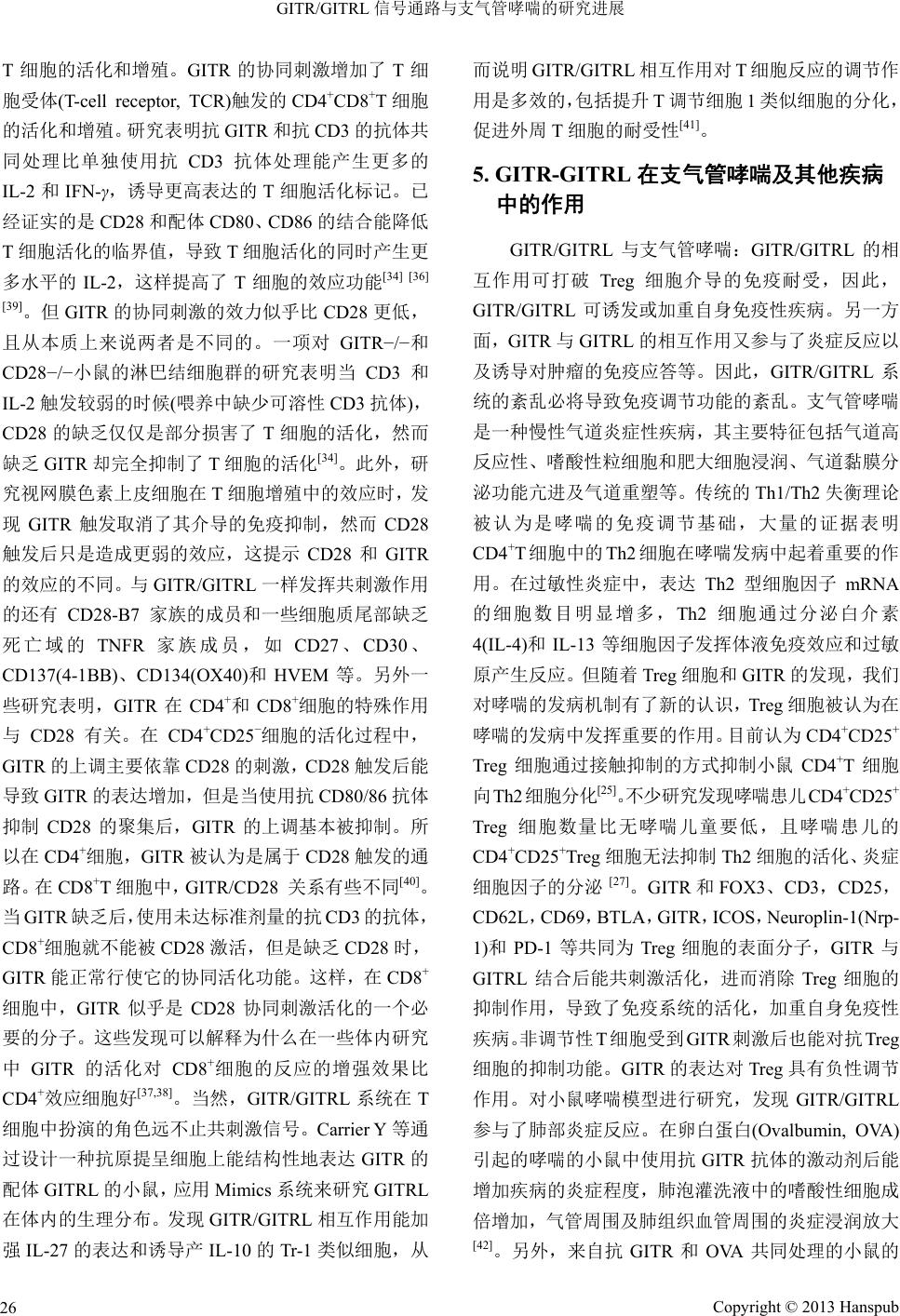 GITR/GITRL信号通路与支气管哮喘的研究进展 T细胞的活化和增殖。GITR 的协同刺激增加了 T细 胞受体(T-cell receptor, TCR)触发的 CD4+CD8+T细胞 的活化和增殖。研究表明抗GITR和抗 CD3 的抗体共 同处理比单独使用抗CD3 抗体处理能产生更多的 IL-2 和IFN-γ,诱导更高表达的 T细胞活化标记。已 经证实的是 CD28 和配体CD80、CD86的结合能降低 T细胞活化的临界值,导致T细胞活化的同时产生更 多水平的 IL-2,这样提高了T细胞的效应功能[34] [36] [39]。但 GITR 的协同刺激的效力似乎比 CD28 更低, 且从本质上来说两者是不同的。一项对GITR−/−和 CD28−/−小鼠的淋巴结细胞群的研究表明当 CD3 和 IL-2 触发较弱的时候(喂养中缺少可溶性CD3 抗体), CD28 的缺乏仅仅是部分损害了 T细胞的活化,然而 缺乏 GITR 却完全抑制了 T细胞的活化[34]。此外,研 究视网膜色素上皮细胞在T细胞增殖中的效应时,发 现GITR 触发取消了其介导的免疫抑制,然而 CD28 触发后只是造成更弱的效应,这提示 CD28 和GITR 的效应的不同。与 GITR/GITRL 一样发挥共刺激作用 的还有 CD28-B7 家族的成员和一些细胞质尾部缺乏 死亡域的TNFR 家族成员,如 CD27 、CD30、 CD137(4-1BB)、CD13 4(OX40) 和HVEM 等。另外一 些研究表明,GITR 在CD4+和CD8+细胞的特殊作用 与CD28 有关。在 CD4+CD25−细胞的活化过程中, GITR 的上调主要依靠CD28 的刺激,CD28 触发后能 导致 GITR 的表达增加,但是当使用抗 CD80/86 抗体 抑制 CD28 的聚集后,GITR的上调基本被抑制。所 以在 CD4+细胞,GITR 被认为是属于CD28 触发的通 路。在 CD8+T细胞中,GITR/CD28 关系有些不同[40]。 当GITR 缺乏后,使用未达标准剂量的抗 CD3 的抗体, CD8+细胞就不能被 CD28 激活,但是缺乏CD28 时, GITR 能正常行使它的协同活化功能。这样,在 CD8+ 细胞中,GITR 似乎是 CD28 协同刺激活化的一个必 要的分子。这些发现可以解释为什么在一些体内研究 中GITR 的活化对CD8+细胞的反应的增强效果比 CD4+效应细胞好[37,38]。当然,GITR/GITRL 系统在 T 细胞中扮演的角色远不止共刺激信号。Carrier Y等通 过设计一种抗原提呈细胞上能结构性地表达 GITR的 配体 GITRL的小鼠,应用Mimics 系统来研究GITRL 在体内的生理分布。发现 GITR/GITRL 相互作用能加 强IL-27的表达和诱导产 IL-10 的Tr-1 类似细胞,从 而说明 GITR/GITRL 相互作用对 T细胞反应的调节作 用是多效的,包括提升 T调节细胞 1类似细胞的分化, 促进外周 T细胞的耐受性[41]。 5. GITR-GITRL在支气管哮喘及其他疾病 中的作用 GITR/GITRL 与支气管哮喘:GITR/GITRL 的相 互作用可打破 Treg 细胞介导的免疫耐受,因此, GITR/GITRL 可诱发或加重自身免疫性疾病。另一方 面,GITR 与GITRL 的相互作用又参与了炎症反应以 及诱导对肿瘤的免疫应答等。因此,GITR/GITRL 系 统的紊乱必将导致免疫调节功能的紊乱。支气管哮喘 是一种慢性气道炎症性疾病,其主要特征包括气道高 反应性、嗜酸性粒细胞和肥大细胞浸润、气道黏膜分 泌功能亢进及气道重塑等。传统的 Th1/Th2 失衡理论 被认为是哮喘的免疫调节基础,大量的证据表明 CD4+T细胞中的 Th2 细胞在哮喘发病中起着重要的作 用。在过敏性炎症中,表达Th2 型细胞因子 mRNA 的细胞数目明显增多,Th2 细胞通过分泌白介素 4(IL-4)和IL-13等细胞因子发挥体液免疫效应和过敏 原产生反应。但随着 Treg 细胞和 GITR的发现,我们 对哮喘的发病机制有了新的认识,Treg 细胞被认为在 哮喘的发病中发挥重要的作用。目前认为 CD4+CD25+ Treg 细胞通过接触抑制的方式抑制小鼠CD4+T细胞 向Th2 细胞分化[25]。不少研究发现哮喘患儿CD4+CD25+ Treg 细胞数量比无哮喘儿童要低,且哮喘患儿的 CD4+CD25+Treg 细胞无法抑制Th2 细胞的活化、炎症 细胞因子的分泌 [27]。GITR和FOX3、CD3,CD25, CD62L,CD 69 ,BTLA,GITR,ICOS,Neuroplin-1(Nrp- 1)和PD-1 等共同为 Treg 细胞的表面分子,GITR 与 GITRL 结合后能共刺激活化,进而消除Treg 细胞的 抑制作用,导致了免疫系统的活化,加重自身免疫性 疾病。非调节性 T细胞受到 GITR刺激后也能对抗 Treg 细胞的抑制功能。GITR 的表达对 Treg 具有负性调节 作用。对小鼠哮喘模型进行研究,发现 GITR/GITRL 参与了肺部炎症反应。在卵白蛋白(Ovalbumin, OVA) 引起的哮喘的小鼠中使用抗GITR 抗体的激动剂后能 增加疾病的炎症程度,肺泡灌洗液中的嗜酸性细胞成 倍增加,气管周围及肺组织血管周围的炎症浸润放大 [42]。另外,来自抗 GITR 和OVA 共同处理的小鼠的 Copyright © 2013 Hanspub 26 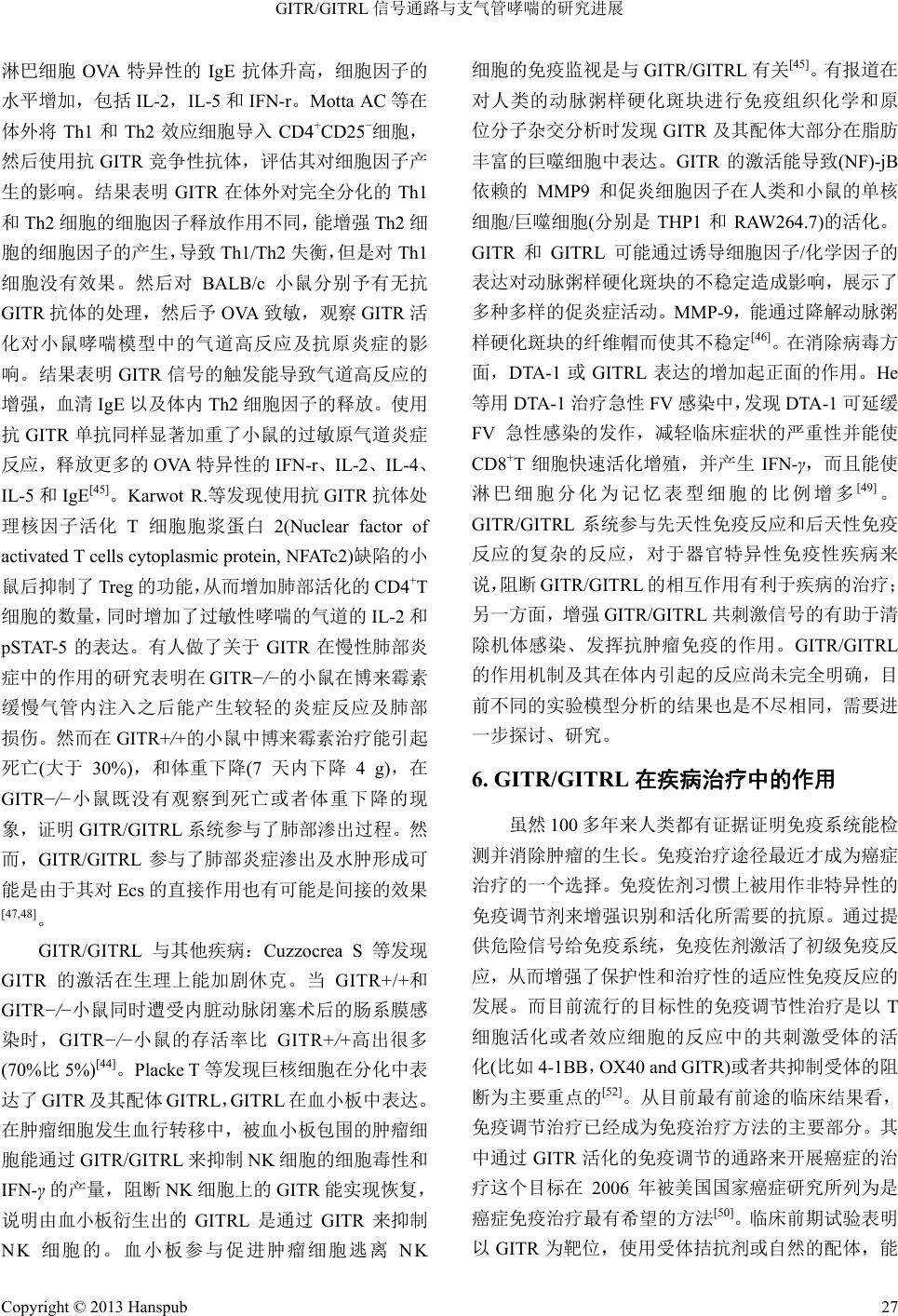 GITR/GITRL信号通路与支气管哮喘的研究进展 淋巴细胞 OVA 特异性的IgE 抗体升高,细胞因子的 水平增加,包括IL-2,IL-5 和IFN-r。Motta AC等在 体外将 Th1 和Th2 效应细胞导入 CD4+CD25−细胞, 然后使用抗 GITR 竞争性抗体,评估其对细胞因子产 生的影响。结果表明 GITR在体外对完全分化的 Th1 和Th2 细胞的细胞因子释放作用不同,能增强 Th2 细 胞的细胞因子的产生,导致Th1/Th2 失衡,但是对 Th1 细胞没有效果。然后对 BALB/c小鼠分别予有无抗 GITR 抗体的处理,然后予 OVA 致敏,观察 GITR 活 化对小鼠哮喘模型中的气道高反应及抗原炎症的影 响。结果表明 GITR 信号的触发能导致气道高反应的 增强,血清IgE 以及体内 Th2细胞因子的释放。使用 抗GITR 单抗同样显著加重了小鼠的过敏原气道炎症 反应,释放更多的OVA 特异性的 IFN-r、IL-2、IL-4、 IL-5 和IgE[45]。Karwot R.等发现使用抗 GITR 抗体处 理核因子活化 T细胞胞浆蛋白 2(Nuclear factor of activated T cells cytoplasmic protein, NFATc2)缺陷的小 鼠后抑制了 Treg 的功能,从而增加肺部活化的 CD4+T 细胞的数量,同时增加了过敏性哮喘的气道的IL-2 和 pSTAT-5 的表达。有人做了关于GITR 在慢性肺部炎 症中的作用的研究表明在 GITR−/−的小鼠在博来霉素 缓慢气管内注入之后能产生较轻的炎症反应及肺部 损伤。然而在GITR+/+的小鼠中博来霉素治疗能引起 死亡(大于 30%),和体重下降(7 天内下降4 g),在 GITR−/−小鼠既没有观察到死亡或者体重下降的现 象,证明GITR/GITRL 系统参与了肺部渗出过程。然 而,GITR/GITRL 参与了肺部炎症渗出及水肿形成可 能是由于其对 Ecs的直接作用也有可能是间接的效果 [47,48]。 GITR/GITRL 与其他疾病:Cuzzocrea S等发现 GITR 的激活在生理上能加剧休克。当 GITR+/+和 GITR−/−小鼠同时遭受内脏动脉闭塞术后的肠系膜感 染时,GITR−/−小鼠的存活率比 GITR+/+高出很多 (70%比5%)[44]。Placke T 等发现巨核细胞在分化中表 达了 GITR及其配体 GITRL,GITRL 在血小板中表达。 在肿瘤细胞发生血行转移中,被血小板包围的肿瘤细 胞能通过 GITR/GITRL 来抑制 NK 细胞的细胞毒性和 IFN-γ的产量,阻断NK 细胞上的GITR 能实现恢复, 说明由血小板衍生出的GITRL 是通过 GITR 来抑制 NK 细胞的。血小板参与促进肿瘤细胞逃离 NK 细胞的免疫监视是与GITR/GITRL 有关[45]。有报 道在 对人类的动脉粥样硬化斑块进行免疫组织化学和原 位分子杂交分析时发现 GITR 及其配体大部分在脂肪 丰富的巨噬细胞中表达。GITR 的激活能导致(NF)-jB 依赖的 MMP9 和促炎细胞因子在人类和小鼠的单核 细胞/巨噬细胞(分别是 THP1和RAW264 .7)的活化。 GITR 和GITRL 可能通过诱导细胞因子/化学因子的 表达对动脉粥样硬化斑块的不稳定造成影响,展示了 多种多样的促炎症活动。MM P - 9,能通过降解动脉粥 样硬化斑块的纤维帽而使其不稳定[46]。在消除病毒方 面,DTA-1 或GITRL 表达的增加起正面的作用。He 等用 DTA-1 治疗急性 FV感染中,发现 DTA-1 可延缓 FV 急性感染的发作,减轻临床症状的严重性并能使 CD8+T细胞快速活化增殖,并产生IFN-γ,而且能使 淋巴细胞分化为记忆表型细胞的比例增多[49] 。 GITR/GITRL 系统参与先天性免疫反应和后天性免疫 反应的复杂的反应,对于器官特异性免疫性疾病来 说,阻断 GITR/GITRL 的相互作用有利于疾病的治疗; 另一方面,增强 GITR/GITRL 共刺激信号的有助于清 除机体感染、发挥抗肿瘤免疫 的作用。GI TR/GITRL 的作用机制及其在体内引起的反应尚未完全明确,目 前不同的实验模型分析的结果也是不尽相同,需要进 一步探讨、研究。 6. GITR/GITRL在疾病治疗中的作用 虽然 100 多年来人类都有证据证明免疫系统能检 测并消除肿瘤的生长。免疫治疗途径最近才成为癌症 治疗的一个选择。免疫佐剂习惯上被用作非特异性的 免疫调节剂来增强识别和活化所需要的抗原。通过提 供危险信号给免疫系统,免疫佐剂激活了初级免疫反 应,从而增强了保护性和治疗性的适应性免疫反应的 发展。而目前流行的目标性的免疫调节性治疗是以T 细胞活化或者效应细胞的反应中的共刺激受体的活 化(比如 4-1BB,OX40 and GITR)或者共抑制受体的阻 断为主要重点的[52]。从目前最有前途的临床结果看, 免疫调节治疗已经成为免疫治疗方法的主要部分。其 中通过 GITR 活化的免疫调节的通路来开展癌症的治 疗这个目标在 2006 年被美国国家癌症研究所列为是 癌症免疫治疗最有希望的方法[50]。临床前期试验表明 以GITR 为靶位,使用受体拮抗剂或自然的配体,能 Copyright © 2013 Hanspub 27 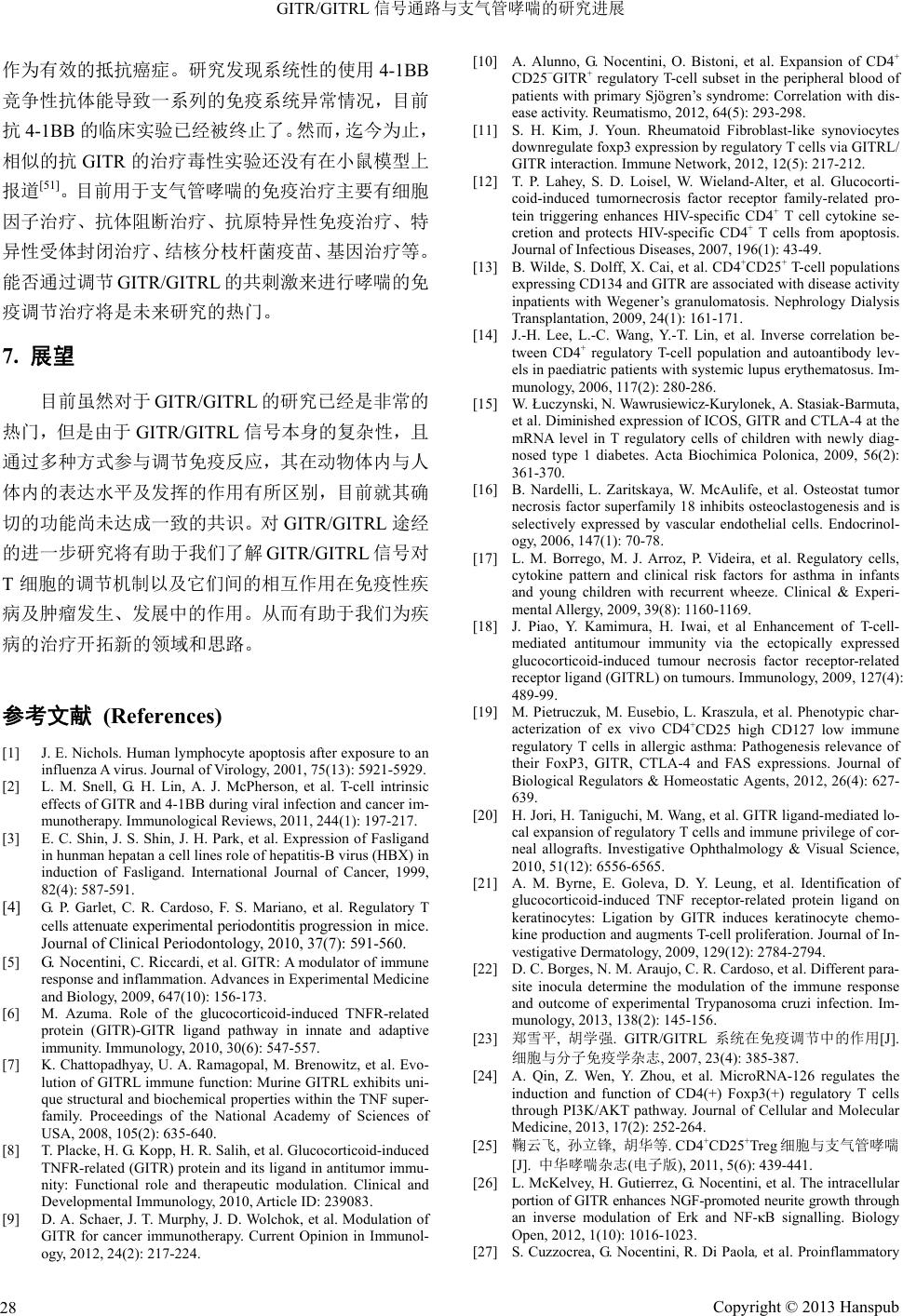 GITR/GITRL信号通路与支气管哮喘的研究进展 作为有效的抵抗癌症。研究发现系统性的使用 4-1BB 竞争性抗体能导致一系列的免疫系统异常情况,目前 抗4-1BB 的临床实验已经被终止了。然而,迄今为止, 相似的抗 GITR 的治疗毒性实验还没有在小鼠模型上 报道[51]。目前用于支气管哮喘的免疫治疗主要有细胞 因子治疗、抗体阻断治疗、抗原特异性免疫治疗、特 异性受体封闭治疗、结核分枝杆菌疫苗、基因治疗等。 能否通过调节 GITR/GITRL 的共刺激来进行哮喘的免 疫调节治疗将是未来研究的热门。 7. 展望 目前虽然对于 GITR/GITRL 的研究已经是非常的 热门,但是由于 GITR/GITRL 信号本身的复杂性,且 通过多种方式参与调节免疫反应,其在动物体内与人 体内的表达水平及发挥的作用有所区别,目前就其确 切的功能尚未达成一致的共识。对 GITR/GITRL途经 的进一步研究将有助于我们了解 GITR/GITRL信号对 T细胞的调节机制以及它们间的相互作用在免疫性疾 病及肿瘤发生、发展中的作用。从而有助于我们为疾 病的治疗开拓新的领域和思路。 参考文献 (References) [1] J. E. Nichols. Human lymphocyte apoptosis after exposure to an influenza A virus. Journal of Virology, 2001, 75(13): 5921-5929. [2] L. M. Snell, G. H. Lin, A. J. McPherson, et al. T-cell intrinsic effects of GITR and 4-1BB during viral infection and cancer im- munotherapy. Immunological Reviews, 2011, 244(1): 197-217. [3] E. C. Shin, J. S. Shin, J. H. Park, et al. Expression of Fasligand in hunman hepatan a cell lines role of hepatitis-B virus (HBX) in induction of Fasligand. International Journal of Cancer, 1999, 82(4): 587-591. [4] G. P. Garlet, C. R. Cardoso, F. S. Mariano, et al. Regulatory T cells attenuate experimental periodontitis progression in mice. Journal of Clinical Periodontology, 2010, 37(7): 591-560. [5] G. Nocentini, C. Riccardi, et al. GITR: A modulator of immune response and inflammation. Advances in Experimental Medicine and Biology, 2009, 647(10): 156-173. [6] M. Azuma. Role of the glucocorticoid-induced TNFR-related protein (GITR)-GITR ligand pathway in innate and adaptive immunity. Immunology, 2010, 30(6): 547-557. [7] K. Chattopadhyay, U. A. Ramagopal, M. Brenowitz, et al. Evo- lution of GITRL immune function: Murine GITRL exhibits uni- que structural and biochemical properties within the TNF super- family. Proceedings of the National Academy of Sciences of USA, 2008, 105(2): 635-640. [8] T. Placke, H. G. Kopp, H. R. Salih, et al. Glucocorticoid-induced TNFR-related (GITR) protein and its ligand in antitumor immu- nity: Functional role and therapeutic modulation. Clinical and Developmental Immunology, 2010, Article ID: 239083. [9] D. A. Schaer, J. T. Murphy, J. D. Wolchok, et al. Modulation of GITR for cancer immunotherapy. Current Opinion in Immunol- ogy, 2012, 24(2): 217-224. [10] A. Alunno, G. Nocentini, O. Bistoni, et al. Expansion of CD4+ CD25−GITR+ regulatory T-cell subset in the peripheral blood of patients with primary Sjögren’s syndrome: Correlation with dis- ease activity. Reumatismo, 2012, 64(5): 293-298. [11] S. H. Kim, J. Youn. Rheumatoid Fibroblast-like synoviocytes downregulate foxp3 expression by regulatory T cells via GITRL/ GITR interaction. Immune Network, 2012, 12(5): 217-212. [12] T. P. Lahey, S. D. Loisel, W. Wieland-Alter, et al. Glucocorti- coid-induced tumornecrosis factor receptor family-related pro- tein triggering enhances HIV-specific CD4+ T cell cytokine se- cretion and protects HIV-specific CD4+ T cells from apoptosis. Journal of Infectious Diseases, 2007, 196(1): 43-49. [13] B. Wilde, S. Dolff, X. Cai, et al. CD4+CD25+ T-cell populations expressing CD134 and GITR are associated with disease activity inpatients with Wegener’s granulomatosis. Nephrology Dialysis Transplantation, 2009, 24(1): 161-171. [14] J.-H. Lee, L.-C. Wang, Y.-T. Lin, et al. Inverse correlation be- tween CD4+ regulatory T-cell population and autoantibody lev- els in paediatric patients with systemic lupus erythematosus. Im- munology, 2006, 117(2): 280-286. [15] W. Łuczynski, N. Wawrusiewicz-Kurylonek, A. Stasiak-Barmuta, et al. Diminished expression of ICOS, GITR and CTLA-4 at the mRNA level in T regulatory cells of children with newly diag- nosed type 1 diabetes. Acta Biochimica Polonica, 2009, 56(2): 361-370. [16] B. Nardelli, L. Zaritskaya, W. McAulife, et al. Osteostat tumor necrosis factor superfamily 18 inhibits osteoclastogenesis and is selectively expressed by vascular endothelial cells. Endocrinol- ogy, 2006, 147(1): 70-78. [17] L. M. Borrego, M. J. Arroz, P. Videira, et al. Regulatory cells, cytokine pattern and clinical risk factors for asthma in infants and young children with recurrent wheeze. Clinical & Experi- mental Allergy, 2009, 39(8): 1160-1169. [18] J. Piao, Y. Kamimura, H. Iwai, et al Enhancement of T-cell- mediated antitumour immunity via the ectopically expressed glucocorticoid-induced tumour necrosis factor receptor-related receptor ligand (GITRL) on tumours. Immunology, 2009, 127(4): 489-99. [19] M. Pietruczuk, M. Eusebio, L. Kraszula, et al. Phenotypic char- acterization of ex vivo CD4+CD25 high CD127 low immune regulatory T cells in allergic asthma: Pathogenesis relevance of their FoxP3, GITR, CTLA-4 and FAS expressions. Journal of Biological Regulators & Homeostatic Agents, 2012, 26(4): 627- 639. [20] H. Jori, H. Taniguchi, M. Wang, et al. GITR ligand-mediated lo- cal expansion of regulatory T cells and immune privilege of cor- neal allografts. Investigative Ophthalmology & Visual Science, 2010, 51(12): 6556-6565. [21] A. M. Byrne, E. Goleva, D. Y. Leung, et al. Identification of glucocorticoid-induced TNF receptor-related protein ligand on keratinocytes: Ligation by GITR induces keratinocyte chemo- kine production and augments T-cell proliferation. Journal of In- vestigative Dermatology, 2009, 129(12): 2784-2794. [22] D. C. Borges, N. M. Araujo, C. R. Cardoso, et al. Different para- site inocula determine the modulation of the immune response and outcome of experimental Trypanosoma cruzi infection. Im- munology, 2013, 138(2): 145-156. [23] 郑雪平, 胡学强. GITR/GITRL 系统在免疫调节中的作用[J]. 细胞与分子免疫学杂志, 2007, 23(4): 385-387. [24] A. Qin, Z. Wen, Y. Zhou, et al. MicroRNA-126 regulates the induction and function of CD4(+) Foxp3(+) regulatory T cells through PI3K/AKT pathway. Journal of Cellular and Molecular Medicine, 2013, 17(2): 252-264. [25] 鞠云飞, 孙立锋, 胡华等. CD4+CD25+Treg 细胞与支气管哮喘 [J]. 中华哮喘杂志(电子版), 2011, 5(6): 439-441. [26] L. McKelvey, H. Gutierrez, G. Nocentini, et al. The intracellular portion of GITR enhances NGF-promoted neurite growth through an inverse modulation of Erk and NF-κB signalling. Biology Open, 2012, 1(10): 1016-1023. [27] S. Cuzzocrea, G. Nocentini, R. Di Paola, et al. Proinflammatory Copyright © 2013 Hanspub 28 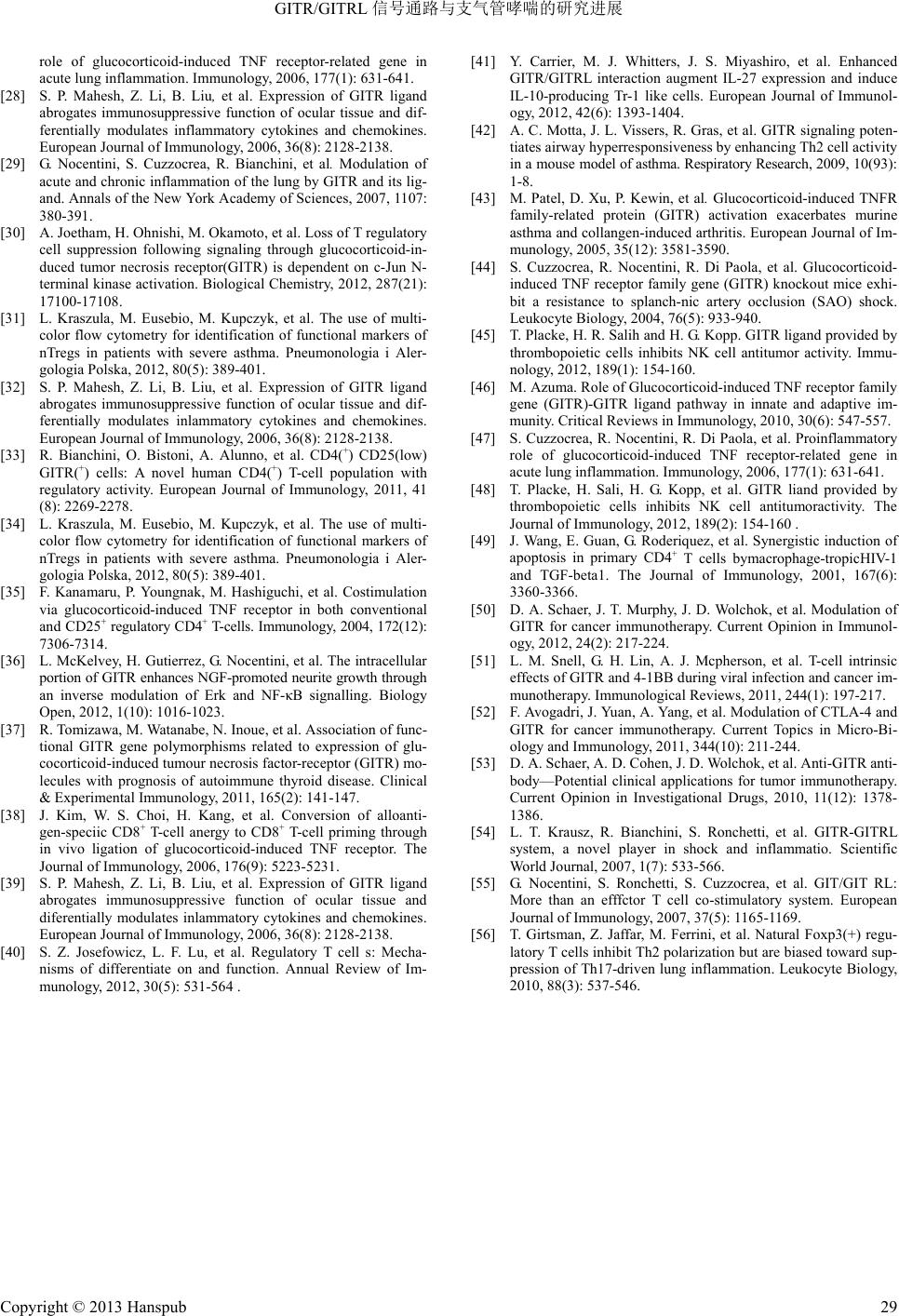 GITR/GITRL信号通路与支气管哮喘的研究进展 Copyright © 2013 Hanspub 29 role of glucocorticoid-induced TNF receptor-related gene in acute lung inflammation. Immunology, 2006, 177(1): 631-641. [28] S. P. Mahesh, Z. Li, B. Liu, et al. Expression of GITR ligand abrogates immunosuppressive function of ocular tissue and dif- ferentially modulates inflammatory cytokines and chemokines. European Journal of Immunology, 2006, 36(8): 2128-2138. [29] G. Nocentini, S. Cuzzocrea, R. Bianchini, et al. Modulation of acute and chronic inflammation of the lung by GITR and its lig- and. Annals of the New York Academy of Sciences, 2007, 1107: 380-391. [30] A. Joetham, H. Ohnishi, M. Okamoto, et al. Loss of T regulatory cell suppression following signaling through glucocorticoid-in- duced tumor necrosis receptor(GITR) is dependent on c-Jun N- terminal kinase activation. Biological Chemistry, 2012, 287(21): 17100-17108. [31] L. Kraszula, M. Eusebio, M. Kupczyk, et al. The use of multi- color flow cytometry for identification of functional markers of nTregs in patients with severe asthma. Pneumonologia i Aler- gologia Polska, 2012, 80(5): 389-401. [32] S. P. Mahesh, Z. Li, B. Liu, et al. Expression of GITR ligand abrogates immunosuppressive function of ocular tissue and dif- ferentially modulates inlammatory cytokines and chemokines. European Journal of Immunology, 2006, 36(8): 2128-2138. [33] R. Bianchini, O. Bistoni, A. Alunno, et al. CD4(+) CD25(low) GITR(+) cells: A novel human CD4(+) T-cell population with regulatory activity. European Journal of Immunology, 2011, 41 (8): 2269-2278. [34] L. Kraszula, M. Eusebio, M. Kupczyk, et al. The use of multi- color flow cytometry for identification of functional markers of nTregs in patients with severe asthma. Pneumonologia i Aler- gologia Polska, 2012, 80(5): 389-401. [35] F. Kanamaru, P. Youngnak, M. Hashiguchi, et al. Costimulation via glucocorticoid-induced TNF receptor in both conventional and CD25+ regulatory CD4+ T-cells. Immunology, 2004, 172(12): 7306-7314. [36] L. McKelvey, H. Gutierrez, G. Nocentini, et al. The intracellular portion of GITR enhances NGF-promoted neurite growth through an inverse modulation of Erk and NF-κB signalling. Biology Open, 2012, 1(10): 1016-1023. [37] R. Tomizawa, M. Watanabe, N. Inoue, et al. Association of func- tional GITR gene polymorphisms related to expression of glu- cocorticoid-induced tumour necrosis factor-receptor (GITR) mo- lecules with prognosis of autoimmune thyroid disease. Clinical & Experimental Immunology, 2011, 165(2): 141-147. [38] J. Kim, W. S. Choi, H. Kang, et al. Conversion of alloanti- gen-speciic CD8+ T-cell anergy to CD8+ T-cell priming through in vivo ligation of glucocorticoid-induced TNF receptor. The Journal of Immunology, 2006, 176(9): 5223-5231. [39] S. P. Mahesh, Z. Li, B. Liu, et al. Expression of GITR ligand abrogates immunosuppressive function of ocular tissue and diferentially modulates inlammatory cytokines and chemokines. European Journal of Immunology, 2006, 36(8): 2128-2138. [40] S. Z. Josefowicz, L. F. Lu, et al. Regulatory T cell s: Mecha- nisms of differentiate on and function. Annual Review of Im- munology, 2012, 30(5): 531-564 . [41] Y. Carrier, M. J. Whitters, J. S. Miyashiro, et al. Enhanced GITR/GITRL interaction augment IL-27 expression and induce IL-10-producing Tr-1 like cells. European Journal of Immunol- ogy, 2012, 42(6): 1393-1404. [42] A. C. Motta, J. L. Vissers, R. Gras, et al. GITR signaling poten- tiates airway hyperresponsiveness by enhancing Th2 cell activity in a mouse model of asthma. Respiratory Research, 2009, 10(93): 1-8. [43] M. Patel, D. Xu, P. Kewin, et al. Glucocorticoid-induced TNFR family-related protein (GITR) activation exacerbates murine asthma and collangen-induced arthritis. European Journal of Im- munology, 2005, 35(12): 3581-3590. [44] S. Cuzzocrea, R. Nocentini, R. Di Paola, et al. Glucocorticoid- induced TNF receptor family gene (GITR) knockout mice exhi- bit a resistance to splanch-nic artery occlusion (SAO) shock. Leukocyte Biology, 2004, 76(5): 933-940. [45] T. Placke, H. R. Salih and H. G. Kopp. GITR ligand provided by thrombopoietic cells inhibits NK cell antitumor activity. Immu- nology, 2012, 189(1): 154-160. [46] M. Azuma. Role of Glucocorticoid-induced TNF receptor family gene (GITR)-GITR ligand pathway in innate and adaptive im- munity. Critical Reviews in Immunology, 2010, 30(6): 547-557. [47] S. Cuzzocrea, R. Nocentini, R. Di Paola, et al. Proinflammatory role of glucocorticoid-induced TNF receptor-related gene in acute lung inflammation. Immunology, 2006, 177(1): 631-641. [48] T. Placke, H. Sali, H. G. Kopp, et al. GITR liand provided by thrombopoietic cells inhibits NK cell antitumoractivity. The Journal of Immunology, 2012, 189(2): 154-160 . [49] J. Wang, E. Guan, G. Roderiquez, et al. Synergistic induction of apoptosis in primary CD4+ T cells bymacrophage-tropicHIV-1 and TGF-beta1. The Journal of Immunology, 2001, 167(6): 3360-3366. [50] D. A. Schaer, J. T. Murphy, J. D. Wolchok, et al. Modulation of GITR for cancer immunotherapy. Current Opinion in Immunol- ogy, 2012, 24(2): 217-224. [51] L. M. Snell, G. H. Lin, A. J. Mcpherson, et al. T-cell intrinsic effects of GITR and 4-1BB during viral infection and cancer im- munotherapy. Immunological Reviews, 2011, 244(1): 197-217. [52] F. Avogadri, J. Yuan, A. Yang, et al. Modulation of CTLA-4 and GITR for cancer immunotherapy. Current Topics in Micro-Bi- ology and Immunology, 2011, 344(10): 211-244. [53] D. A. Schaer, A. D. Cohen, J. D. Wolchok, et al. Anti-GITR anti- body—Potential clinical applications for tumor immunotherapy. Current Opinion in Investigational Drugs, 2010, 11(12): 1378- 1386. [54] L. T. Krausz, R. Bianchini, S. Ronchetti, et al. GITR-GITRL system, a novel player in shock and inflammatio. Scientific World Journal, 2007, 1(7): 533-566. [55] G. Nocentini, S. Ronchetti, S. Cuzzocrea, et al. GIT/GIT RL: More than an efffctor T cell co-stimulatory system. European Journal of Immunology, 2007, 37(5): 1165-1169. [56] T. Girtsman, Z. Jaffar, M. Ferrini, et al. Natural Foxp3(+) regu- latory T cells inhibit Th2 polarization but are biased toward sup- pression of Th17-driven lung inflammation. Leukocyte Biology, 2010, 88(3): 537-546. |